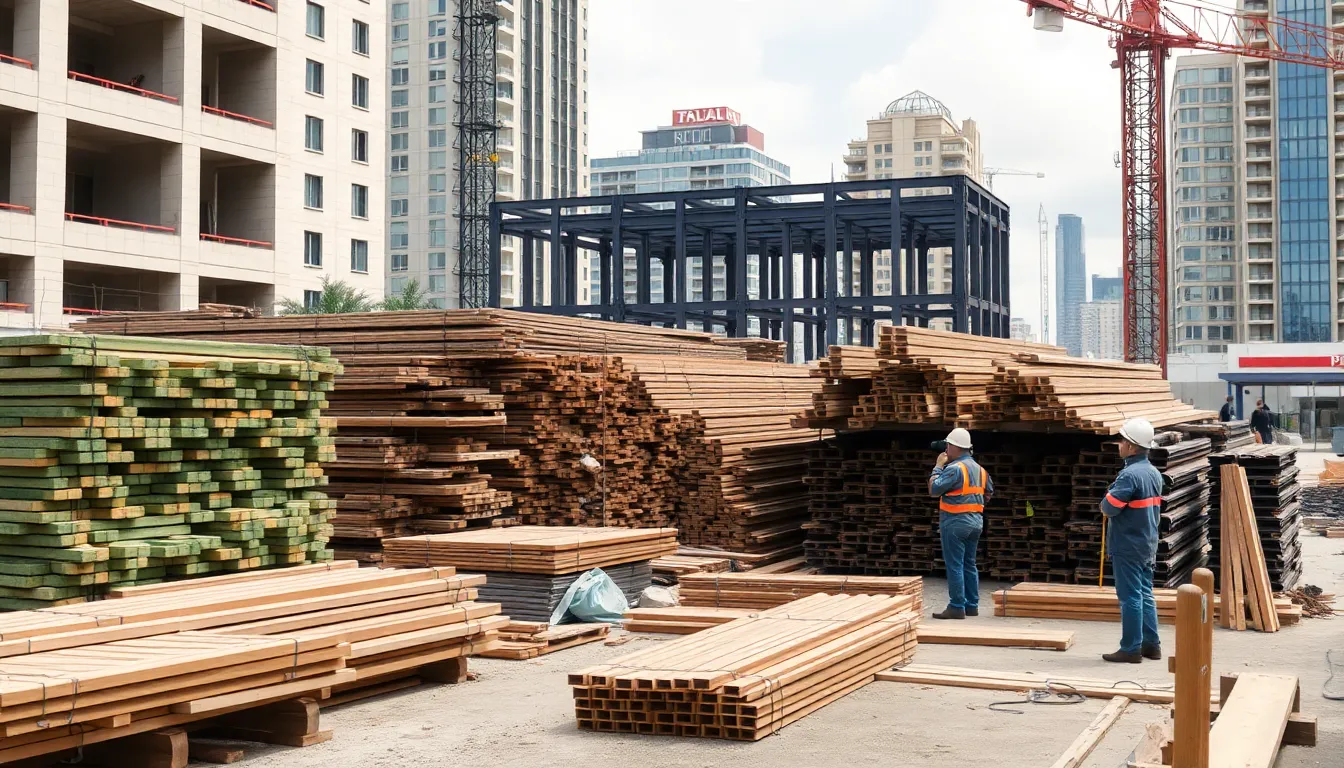In today’s rapidly evolving construction industry, understanding building materials cost is crucial for homeowners, contractors, and architects alike. As project budgets tighten and supply chain challenges persist, knowing how to navigate these expenses can make or break a project.
Prices for essential materials like lumber, steel, and concrete fluctuate significantly, influenced by factors such as demand, availability, and global market trends. By staying informed about these costs, stakeholders can make smarter decisions, optimize their budgets, and ensure their projects remain on track.
This article will delve into the current landscape of building materials costs, exploring key factors that affect pricing and offering insights to help readers manage their construction expenses effectively.
Table of Contents
ToggleOverview of Building Materials Cost
Understanding building materials cost remains essential for stakeholders in the construction industry. Building material prices can be volatile, fluctuating due to factors such as demand, supply chain disruptions, and global market trends.
The following table outlines the average costs for key building materials as of 2023:
| Material | Average Cost per Unit | Price Trend (%) |
|---|---|---|
| Lumber | $3.50 per board foot | -10% |
| Steel | $1,200 per ton | +15% |
| Concrete | $120 per cubic yard | +5% |
| Drywall | $12 per sheet | Stable |
| Insulation | $0.50 per square foot | +7% |
Lumber prices saw a decline of 10% compared to the previous year, reflecting improved supply chains. Steel prices increased by 15%, primarily due to international trade policies and raw material shortages. Concrete pricing has remained comparatively stable with a slight increase of 5%.
Pricing variations occur based on local markets and specific supplier contracts. Homeowners and contractors should evaluate potential cost variances in multiple geographic locations. Monitoring price trends regularly allows for more accurate budgeting and project planning.
Making informed decisions calls for assessing not just material costs, but also quality, sustainability, and energy efficiency. The long-term value of building materials often outweighs initial expenditure, emphasizing the importance of considering overall project affordability.
Factors Influencing Building Materials Cost

Several factors significantly impact building materials costs in the construction industry. Understanding these elements helps stakeholders make informed decisions and manage budgets effectively.
Supply and Demand Dynamics
Supply and demand dynamics play a crucial role in determining material costs. When demand rises, prices increase, particularly for materials like lumber and steel. Seasonal fluctuations often drive demand; for example, warmer months see higher construction activity, which can inflate prices. Conversely, when supply chain disruptions occur—due to natural disasters or geopolitical issues—availability decreases, pushing costs higher. Monitoring both market conditions and seasonal trends is essential for accurate budgeting.
Geographic Location
Geographic location directly affects building materials costs. Proximity to suppliers influences shipping costs and overall price, with urban areas generally experiencing higher prices due to demand and logistical costs. Regional availability of specific materials also varies; for instance, coastal areas might have more access to concrete aggregates, reducing expenses. Understanding local market conditions ensures cost-efficient procurement strategies and helps avoid budget overruns.
Material Quality and Specifications
Material quality and specifications impact costs significantly. Higher-quality materials often come with increased price tags but provide better durability and energy efficiency. Compliance with local building codes and regulations may dictate specific material specifications, thereby influencing costs. For example, sustainable materials might have a higher initial cost but lower long-term expenses due to energy savings. Evaluating both immediate costs and long-term benefits guides better investment decisions in building materials.
Major Types of Building Materials
Understanding the various types of building materials helps stakeholders gauge costs and select appropriate options for projects. Key materials include concrete and cement, steel, wood, and sustainable alternatives.
Concrete and Cement
Concrete, a mixture of cement, water, and aggregates, is vital in construction. At $120 per cubic yard as of 2023, concrete costs reflect a 5% increase from the previous year. Demand for concrete grows due to its strength and versatility. Cement serves as a crucial component in concrete, typically priced between $100 and $150 per ton. Builders often choose concrete for its durability and ability to withstand various environmental conditions.
Steel
Steel plays a significant role in structural integrity, especially in commercial projects. Priced at $1,200 per ton in 2023, steel experiences a 15% rise in costs due to supply chain issues and demand fluctuations. Steel’s strength-to-weight ratio makes it ideal for high-rise buildings and bridges. Its ability to be recycled enhances its appeal, although production costs can vary substantially based on global market trends and raw material availability.
Wood
Wood remains a fundamental material in construction, often used for framing and finishing. As of 2023, lumber prices average $3.50 per board foot, a 10% decrease influenced by improved supply chains. Wood’s natural insulating properties offer energy efficiency benefits. Builders choose specific wood types based on aesthetics, structural needs, and sustainability considerations.
Sustainable Materials
Sustainable materials gain traction as a response to environmental concerns. These include recycled steel, bamboo, and reclaimed wood, which often present higher upfront costs but provide long-term savings through energy efficiency and durability. Stakeholders recognize the importance of life-cycle assessments to evaluate true costs and benefits. Utilizing sustainable materials can bolster community support and enhance project resilience.
Current Trends in Building Materials Cost
Current trends in building materials cost reveal significant influence from global events and technological advancements. Stakeholders must recognize these factors to navigate fluctuating prices effectively.
Impact of Global Events
Global events play a crucial role in shaping building materials costs. Events like pandemics, geopolitical tensions, and natural disasters disrupt supply chains, causing price volatility. For example, the COVID-19 pandemic resulted in significant reductions in labor supply and transportation delays, impacting availability and driving prices higher. Additionally, tariffs and trade policies can restrict imports, contributing to rising costs for materials like steel and aluminum. For 2023, some materials experienced cost surges for this reason, highlighting the interconnectedness of global commerce and local construction prices.
Technological Advancements
Technological advancements significantly alter the landscape of building materials costs. Innovations in manufacturing and supply chain management create efficiencies that can lower expenses. The rise of automation in production enhances precision while reducing waste, directly correlating to cost reductions. Digital tools like Building Information Modeling (BIM) improve project planning and resource management, further optimizing expenditures. Moreover, advancements in sustainable materials, such as high-performance insulation and eco-friendly concrete alternatives, may present higher upfront costs but offer long-term savings through energy efficiency. Stakeholders leveraging technology can optimize their procurement strategies and mitigate the impacts of rising material costs.
Understanding building materials costs is crucial for anyone involved in construction. With prices fluctuating due to various factors like supply chain disruptions and demand spikes, staying informed helps stakeholders make better financial decisions.
Evaluating costs across different materials and locations allows for more accurate budgeting. Emphasizing quality and sustainability can lead to long-term benefits that outweigh initial expenses.
By leveraging technology and staying updated on market trends, homeowners and contractors can navigate challenges effectively. This approach not only ensures project success but also contributes to a more resilient construction industry.



